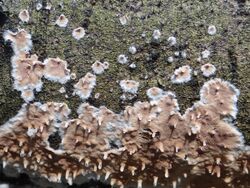Biology:Cylindrobasidium laeve
| Cylindrobasidium laeve | |
|---|---|

| |
| Scientific classification | |
| Domain: | Eukaryota |
| Kingdom: | Fungi |
| Division: | Basidiomycota |
| Class: | Agaricomycetes |
| Order: | Agaricales |
| Family: | Physalacriaceae |
| Genus: | Cylindrobasidium |
| Species: | C. laeve
|
| Binomial name | |
| Cylindrobasidium laeve (Pers.) Chamuris, 1984[1]
| |
| Synonyms[2] | |
| |
Cylindrobasidium is a species of fungus in the family Physalacriaceae.
A product which contains Cylindrobasidium laeve as the active ingredient can be used as a mycoherbicide to control Acacia mearnsii (black wattle) in South Africa .[3]
Taxonomy
Initially described by Persoon in 1794 as Corticium laeve, the modern Index Fungorum name was given in 1984 by George Peter Chamuris.[4]
In Europe
It is very common in Poland , usually found on various types of forests, bushes, parks, gardens, roadsides, trunks and branches of deciduous trees. It was found on the following species and types of trees: maples, chestnut tree, alder, silver birch, hornbeam, hazel, hawthorn, beech, hairy ash, apple, black poplar, plum tree, Robinia pseudoacacia, willow, and lime. It occurs rarely on conifers.[5]
Gallery
- Evidence of C. laeve
References
- ↑ Christiaan Hendrik Persoon George Peter Chamuris, Mycotaxon 20(2): 587 (1984)
- ↑ "Cylindrobasidium laeve" (in en) (html). http://www.speciesfungorum.org/GSD/GSDspecies.asp?RecordID=106750. Retrieved 5 September 2019.
- ↑ "15 - Plant Pathogens for Controlling Weeds". Natural Enemies An Introduction to Biological Control. Cambridge: University of Cambridge. July 2018. pp. 278–288. doi:10.1017/9781107280267.016. ISBN 9781107280267. https://www.cambridge.org/core/books/natural-enemies/plant-pathogens-for-controlling-weeds/F28657DA292FB313B4B26482448BFF3E.
- ↑ "Index Fungorum - Names Record". http://www.indexfungorum.org/names/NamesRecord.asp?RecordID=106750. Retrieved 5 September 2019.
- ↑ Wojewoda, Władysław (2003). Checklist of Polish Larger Basidiomycetes. Krytyczna lista wielkoowocnikowych grzybów podstawkowych Polski. Kraków: W. Szafer Institute of Botany, Polish Academy of Sciences. ISBN 83-89648-09-1.
Offsite
- BioNET-EAFRINET: Acacia mearnsii (Black Wattle)
- Mycobank: Cylindrobasidium laeve
- Scottish fungi: Cylindrobasidium laeve
Wikidata ☰ Q10464389 entry
 |






